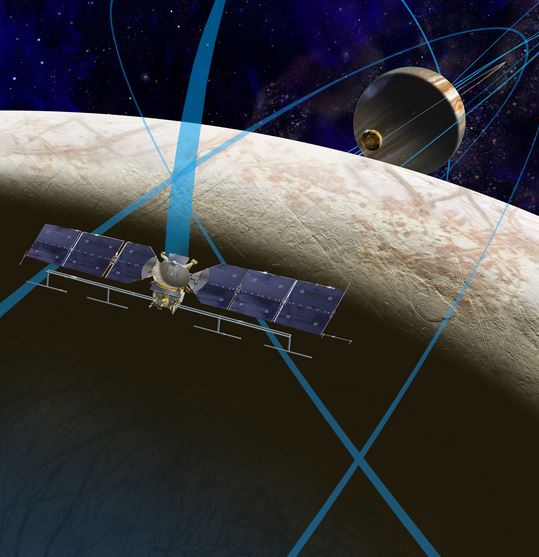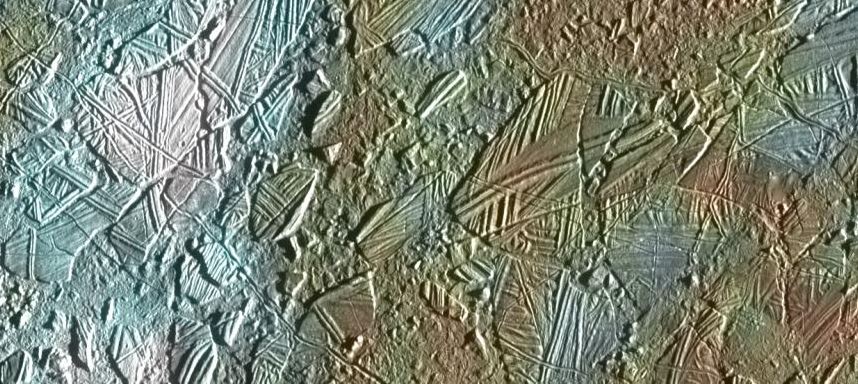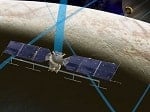Does Jupiter’s icy moon Europa harbor life as we know it? This is something NASA wants to find out after selecting nine scientific instruments for a mission. The aim will be twofold: 1. Does the moon harbor conditions suitable for life? 2. Is there life there?
According to data from NASA’s Galileo mission, there is strong evidence that Europa, which is about the size of our Moon, has an ocean beneath a frozen crust.
If the existence of this ocean is confirmed, it would have about twice as much water as Earth.
According to data gathered so far, Europa has abundant salt water, a rocky sea floor, and the energy and chemistry provided by tidal heating. It could well be the most suitable place in our solar system, apart from Earth, for life as we know it.
 This artist’s impression shows a concept for a future NASA mission to Europa. (Image: NASA/JPL-Caltech)
This artist’s impression shows a concept for a future NASA mission to Europa. (Image: NASA/JPL-Caltech)
Associate administrator for NASA’s Science Mission Directorate in Washington, John Grunsfeld said:
“Europa has tantalized us with its enigmatic icy surface and evidence of a vast ocean, following the amazing data from 11 flybys of the Galileo spacecraft over a decade ago and recent Hubble observations suggesting plumes of water shooting out from the moon.”
“We’re excited about the potential of this new mission and these instruments to unravel the mysteries of Europa in our quest to find evidence of life beyond Earth.”
There are $30 million set aside from NASA’s fiscal year 2016 budget to formulate a mission to Europa. The mission would send a solar-powered probe into a long, looping orbit around Jupiter, the gas giant, to perform repeated close flybus of Europe over a period of 36 months.
The mission would perform forty-five flybys at altitues between 16 and 1,700 miles (25 and 2,700 km).
Several key instruments selected
NASA has selected cameras and spectrometers to produce high-resolution images of Europa’s surface and determine its composition.
NASA also selected an ice penetrating radar to determine how thick Europe’s icy shell is, and to search for subsurface lakes similar to those that exist beneath Antarctica.
The probe will also be equipped with a magnetometer, to measure the strength and direction of Europa’s magnetic field, which will allow researchers to determine the salinity and depth of its ocean.
The thermal instrument will scour the moon’s frozen surface, seeking out recent eruptions of warmer water, while other instruments will search for evidence of water and tiny particles on its thin atmosphere.
 Bizarre features on Europa’s icy surface suggest a warm interior. (Image: NASA/JPL-Caltech)
Bizarre features on Europa’s icy surface suggest a warm interior. (Image: NASA/JPL-Caltech)
In 2012, NASA’s Hubble Space Telescope detected water vapour above the south polar region of Jupiter’s moon, providing the first compelling evidence of water plumes.
If the next probe can confirm the existence of the plumes, it’ll help researchers investigate the chemical makeup of Europa’s potentially habitable environment while minimizing the need to drill through layers of ice.
After inviting researchers last year to submit proposals for instruments to study Europa, nine were selected out of a total of 33 submissions. NASA expects the mission will be launched some time during the next decade.
Curt Niebur, Europa program scientist at NASA Headquarters in Washington, said:
“This is a giant step in our search for oases that could support life in our own celestial backyard. We’re confident that this versatile set of science instruments will produce exciting discoveries on a much-anticipated mission.”

